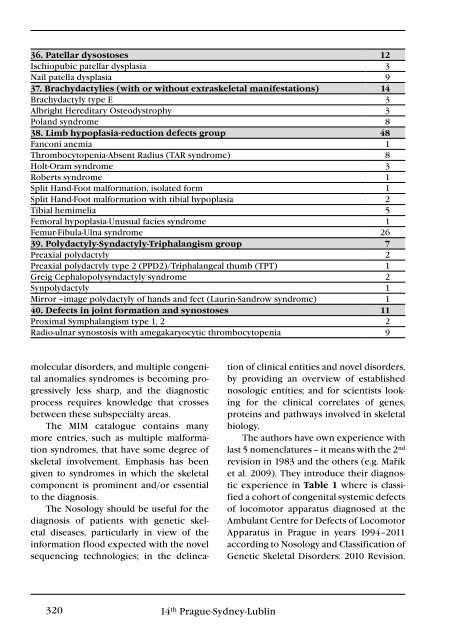3+4+Supplementum/2012 - Společnost pro pojivové tkáně
3+4+Supplementum/2012 - Společnost pro pojivové tkáně
3+4+Supplementum/2012 - Společnost pro pojivové tkáně
- TAGS
- www.pojivo.cz
Create successful ePaper yourself
Turn your PDF publications into a flip-book with our unique Google optimized e-Paper software.
36. Patellar dysostoses 12<br />
Ischiopubic patellar dysplasia 3<br />
Nail patella dysplasia 9<br />
37. Brachydactylies (with or without extraskeletal manifestations) 14<br />
Brachydactyly type E 3<br />
Albright Hereditary Osteodystrophy 3<br />
Poland syndrome 8<br />
38. limb hypoplasia-reduction defects group 48<br />
Fanconi anemia 1<br />
Thrombocytopenia-Absent Radius (TAR syndrome) 8<br />
Holt-Oram syndrome 3<br />
Roberts syndrome 1<br />
Split Hand-Foot malformation, isolated form 1<br />
Split Hand-Foot malformation with tibial hypoplasia 2<br />
Tibial hemimelia 5<br />
Femoral hypoplasia-Unusual facies syndrome 1<br />
Femur-Fibula-Ulna syndrome 26<br />
39. Polydactyly-Syndactyly-Triphalangism group 7<br />
Preaxial polydactyly 2<br />
Preaxial polydactyly type 2 (PPD2)/Triphalangeal thumb (TPT) 1<br />
Greig Cephalopolysyndactyly syndrome 2<br />
Synpolydactyly 1<br />
Mirror –image polydactyly of hands and feet (Laurin-Sandrow syndrome) 1<br />
40. defects in joint formation and synostoses 11<br />
Proximal Symphalangism type 1, 2 2<br />
Radio-ulnar synostosis with amegakaryocytic thrombocytopenia 9<br />
molecular disorders, and multiple congenital<br />
anomalies syndromes is becoming <strong>pro</strong>gressively<br />
less sharp, and the diagnostic<br />
<strong>pro</strong>cess requires knowledge that crosses<br />
between these subspecialty areas.<br />
The MIM catalogue contains many<br />
more entries, such as multiple malformation<br />
syndromes, that have some degree of<br />
skeletal involvement. Emphasis has been<br />
given to syndromes in which the skeletal<br />
component is <strong>pro</strong>minent and/or essential<br />
to the diagnosis.<br />
The Nosology should be useful for the<br />
diagnosis of patients with genetic skeletal<br />
diseases, particularly in view of the<br />
information flood expected with the novel<br />
sequencing technologies; in the delinea-<br />
320 14 th Prague-Sydney-Lublin<br />
tion of clinical entities and novel disorders,<br />
by <strong>pro</strong>viding an overview of established<br />
nosologic entities; and for scientists looking<br />
for the clinical correlates of genes,<br />
<strong>pro</strong>teins and pathways involved in skeletal<br />
biology.<br />
The authors have own experience with<br />
last 5 nomenclatures – it means with the 2 nd<br />
revision in 1983 and the others (e.g. Mařík<br />
et al. 2009). They introduce their diagnostic<br />
experience in Table 1 where is classified<br />
a cohort of congenital systemic defects<br />
of locomotor apparatus diagnosed at the<br />
Ambulant Centre for Defects of Locomotor<br />
Apparatus in Prague in years 1994–2011<br />
according to Nosology and Classification of<br />
Genetic Skeletal Disorders: 2010 Revision.

















